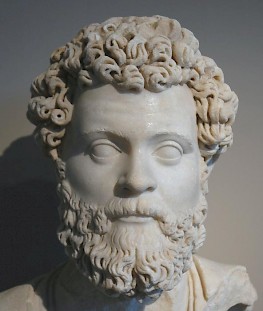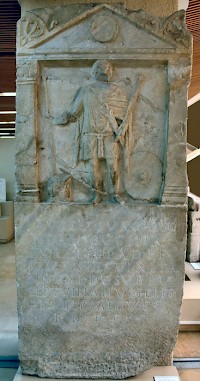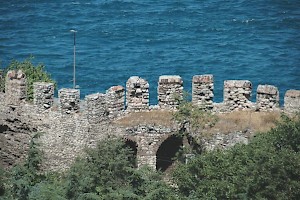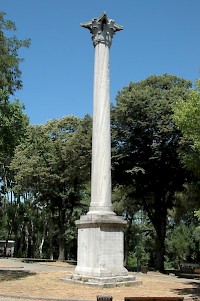Roman Byzantium
Constantinople (Κωνσταντινούπολις) or Byzantium (Βυζάντιον): Greek city on the Bosphorus, capital of the Byzantine Empire, modern İstanbul.

Seen from Rome, Byzantium was the city at the end of the Via Egnatia, the large road that the Romans had built from the Adriatic Sea through Macedonia to the Bosphorus. Byzantium had been consistently pro-Rome,note and was recognized as an important ally, a civitas libera et foederata. It was about the size of Pompeii, with some 15,000 people living within the walls and about as many people living in the countryside.
The emperors liked the city. Roman baths, thermae, were built near the shrine of Achilles in the northern part of the city; there was a lighthouse (only known from coins; and Hadrian (117-138) gave an aqueduct, which is now called after the emperor who repaired the monument: the Aqueduct of Valens. According to the author Dionysius of Byzantium, the walls were thirty-five stades long, or about six kilometer, and the sector that was facing the land was about five stades wide, less than a kilometer. From twenty-seven towers, catapults could be fired. This means that the city was almost impossible to capture. However, war was to come, and it was to be terrible.

On the last day of 192, the emperor Commodus was assassinated, and on 1 January 193, the Senate recognized the old general Pertinax as new master of the Roman world. The venerable man was killed, however, and war broke out between Septimius Severus - who occupied Italy immediately - and Pescennius Niger in Syria and Anatolia. Herodian says:
Niger sent an army to occupy Byzantium in Thrace, at that time a large and prosperous city rich in men and money. Located at the narrowest part of the Propontic Gulf, Byzantium grew immensely wealthy from its marine revenues, both tolls and fish; the city owned much fertile land, too, and realized a very handsome profit from all these sources. Niger wished to have this city under his control because it was very strong, but especially because he hoped to be able to prevent any crossing from Europe and Asia by way of the Propontic Gulf. Byzantium was surrounded by a huge, strong wall of millstones cut to rectangular shape and fitted so skillfully that it was impossible to determine where the courses were joined; the entire wall appeared to be a single block of stone.note
Severus sent the two easternmost legions of the Danube, I Italica and XI Claudia, but when they arrived, they discovered that Byzantium had sided with Pescennius Niger, and that a second enemy army was at Cyzicus, to the south. However, when Severus personally appeared on the scene, Pescennius retreated, and Severus' soldiers could cross to Asia. Near Nicaea, modern İznik, the two armies of Pescennius were defeated.note Byzantium, however, refused to surrender. It is possible that Aurelius Surus of the First legion Adiutrix, whose tombstone can today be admired in the Archaeological Museum, was killed in action.

It held out until 195. Herodian:
Byzantium was captured as a result of famine, and the entire city was razed. Stripped of its theaters and baths and, indeed, of all adornments, the city, now only a village, was given to the Perinthians to be subject to them [...]. Severus made available a huge sum of money for rebuilding the cities destroyed by Niger's soldiers.note
Later, Severus regretted his harsh policy. In 203, it was reoccupied again, and the walls were rebuilt. A part of the Severan sea walls is still visible in the northeast of modern İstanbul. The land walls were probably about 300 m west of the old walls. New was the road known as Mese, which began at Tetrastôn Square and led to the west, where it continued as Via Egnatia. In the fourth century, it was to become the main axis of Constantinople; today, it is known as Divan Yolu Caddesi, Yeniçeriler Caddesi and Ordu Caddesi.

Tetrastôn Square also witnessed the construction of the Baths of Zeuxippus, and - a stone's throw away - the hippodrome. The temples, theater, and amphitheater on the eastern slope of the acropolis were rebuilt; on the western slope, a gymnasium was constructed. The rebuilding lasted several years, and it was only during the reign of Severus' son and successor Caracalla that the city was completed. Hence, the city was briefly called Antonina, after the emperor's official name.
In the 260s, the Balkans were invaded by several tribes, which are collectively called the Goths. One of them, the Herulians, managed to capture Byzantium in 267. Two years later, the emperor Claudius II defeated the invaders decisively, an event that was commemorated in Byzantium by erecting the Column of the Goths.
By this time, Byzantium had a Christian community, led by a bishop that was appointed by the metropolite of Heraclea. The famous story that the church of Byzantium was founded by the apostle Andrew, the brother of Peter, is almost certainly incorrect, as it is not mentioned before the fifth century. The Christians were persecuted by emperors like Decius, Valerian, Diocletian, and Galerius, but the last-mentioned put an end to this policy in 311. Not much later, his successor Licinius, acting together with his colleague Constantine, decreed religious freedom for the Christians ("Edict of Milan", 313). The main church was, at that moment, the Church of Divine Peace.